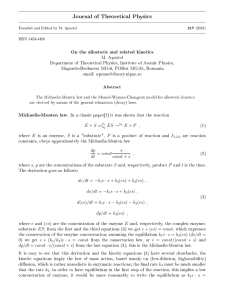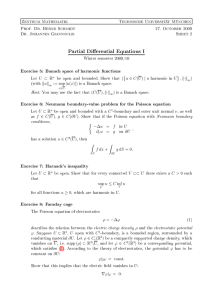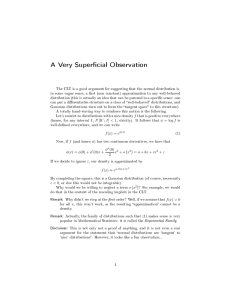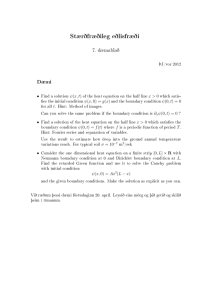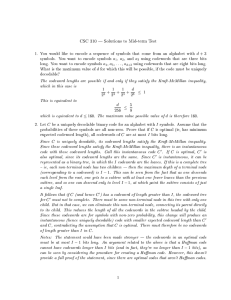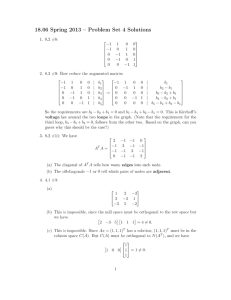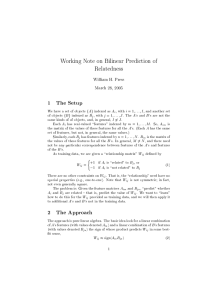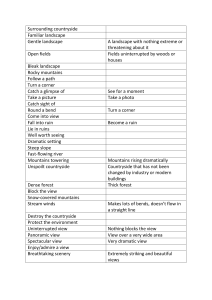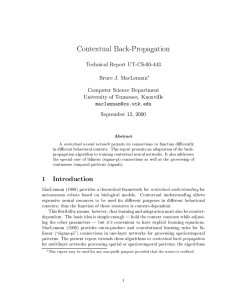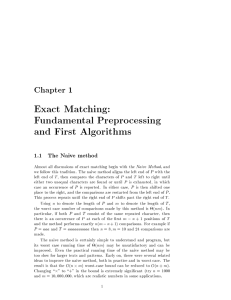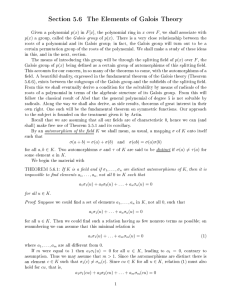я п жЁв йы р ¹ х жь ¾
advertisement
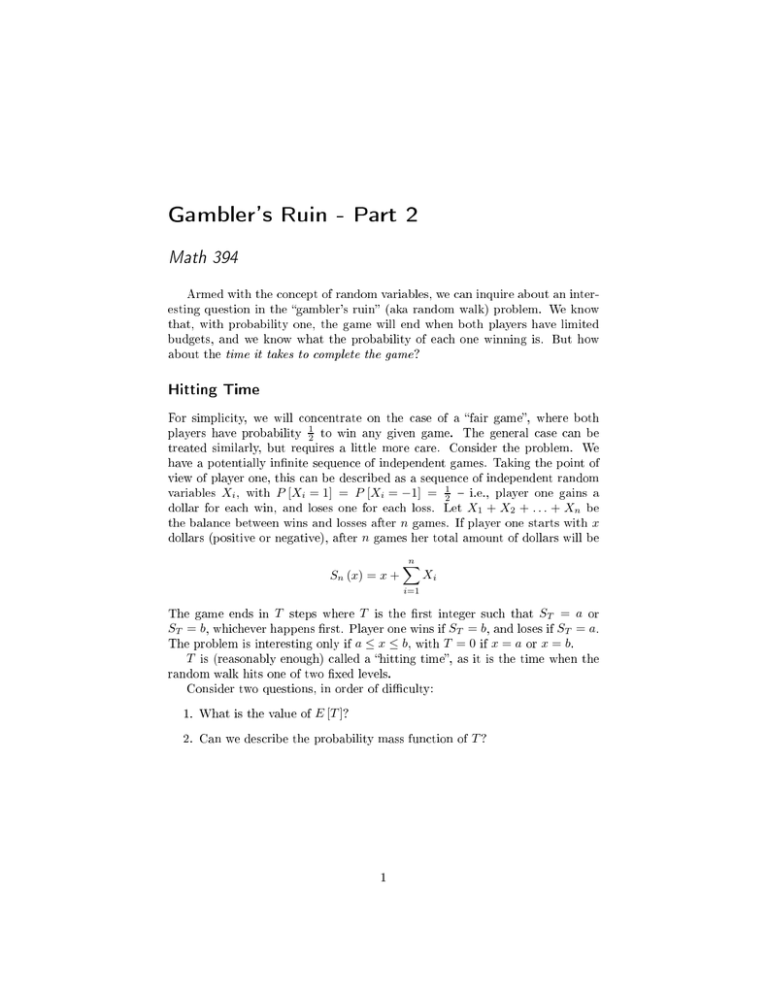
Gambler's Ruin - Part 2 Math 394 Armed with the onept of random variables, we an inquire about an interesting question in the gambler's ruin (aka random walk) problem. We know that, with probability one, the game will end when both players have limited budgets, and we know what the probability of eah one winning is. But how about the time it takes to omplete the game ? Hitting Time For simpliity, we will onentrate on the ase of a fair game, where both 1 players have probability 2 to win any given game. The general ase an be treated similarly, but requires a little more are. Consider the problem. We have a potentially innite sequene of independent games. Taking the point of view of player one, this an be desribed as a sequene of independent random 1 variables Xi , with P [Xi = 1] = P [Xi = −1] = 2 i.e., player one gains a dollar for eah win, and loses one for eah loss. the balane between wins and losses after dollars (positive or negative), after n n Let X1 + X2 + . . . + Xn be games. If player one starts with x games her total amount of dollars will be Sn (x) = x + n X Xi i=1 T steps where T is the rst integer suh that ST = a or ST = b, whihever happens rst. Player one wins if ST = b, and loses if ST = a. The problem is interesting only if a ≤ x ≤ b, with T = 0 if x = a or x = b. T is (reasonably enough) alled a hitting time, as it is the time when the The game ends in random walk hits one of two xed levels. Consider two questions, in order of diulty: 1. What is the value of E [T ]? 2. Can we desribe the probability mass funtion of 1 T? 1 Expeted Hitting Time 1 2 Expeted Hitting Time The trik to nd E [T ] is very similar to the one used to nd the probability of win or ruin that we disussed earlier. There is a slight adjustment to make, as we are now ounting how many steps we will need. Note that on the starting point x. E [T ] will depend As before, we onsider the two possibilities for the outome of the rst game: player one either wins (X1 = 1), or loses (X1 = −1). Sine onditional probabilities are probabilities, we an ompute expetations with respet to them. two boundaries, We will onsider the time it takes to reah one of the onditional on starting from x, expetation, onditional on this, as Px and Ex , and write probabilities and as shorthand (this is a ommon notation in this kind of problems). After the rst game, we will be either in x+1 or in x − 1, and, by inde- pendene, the game starts from srath from this point. However, one unit of time has been used up. Thus, onditioning on the two possible outomes of the rst game, Ex [T ] = 1 + Ex+1 [T ] 1 1 + Ex−1 [T ] 2 2 1 1 (Ex+1 [T ] − Ex [T ]) + (Ex−1 [T ] − Ex [T ]) = −1 2 2 You will reognize that the same alulation will work at any time step. Thus, if we dene u(x) = Ex [T ] we have the dierene equation 1 1 [u (x + 1) − u (x)] + [u (x − 1) − u (x)] = −1, 2 2 u (a) = u (b) = 0 (1) We ould try to guess what a solution to this equation ould look like, but to help our intuition, let's take a limit similar to the one we took in the original gambler's ruin problem, whih led us to a dierential equation. That is, let's hange the size of the step to a small number, say h. Now, if the steps are shorter, we need to walk faster. That is the time step has to beome shorter too no longer 1. If we hoose a time step also equal to h we don't get very far: 1 [u(x + h) − u(x)] + 2 1 u(x + h) − u(x) + 2 h and in the limit 0 = 1, h → 0, 1 [u(x − h) − u(x)] = −h 2 1 u(x − h) − u(x) = −1 2 h if we assume u to be dierentiable, we end up with meaning the equation does not have a limit. 1 Expeted Hitting Time Let's then try h2 . 3 This time we are on to something: 1 1 [u(x + h) − u(x)] + [u(x − h) − u(x)] = −h2 2 2 1 u(x − h) − u(x) 1 u(x + h) − u(x) + = −1 2 h2 2 h2 1 ′′ ′ 2 and with u(x + h) − u(x) ≈ u (x) · h + u (x) · h , 2 1 ′′ 2 h + 2 u (x) · h , our equation has a proper limit: 1 ′′ u (x) = −1, 2 u(x − h) − u(x) ≈ −u′ (x) · u(a) = u(b) = 0 (2) Dirihlet problem for a Pois- (This is a one-dimensional version of the so-alled ′′ Solving u = −2 yields, as a general solution son equation ). B, where and b A and B are determined by the boundary u(x) = −x2 + Ax + onditions, that is that a be the roots of the polynomial, i.e. −x2 + Ax + B = − (x − a) (x − b) that is A = (a + b), B = −ab It is not hard to hek that we will get the same result if we plug a tentative 2 solution of the form −x + Ax + B into equation (1), or, equivalently, we hek 2 that −x + (a + b) x − ab solves (1). Consider now the limit ase as to reah a barrier of height b a → −∞. This would result in the time with no lower bound. Sine the solution to our equation (2) an only be quadrati, we see that there is no solution in this ase. If we look at the solution u(x) = −x2 + (a + b) x − ab for xed x, it will look like a(x − b), whih, as a → ∞, diverges to ∞. In other x = b will be reahed with probability 1 (in fat, words, even though the barrier hoosing x = b − 1, it will be reahed in just one step with probability average it will take an innite number of steps to reah it. Note: 1 2 ), on Feller, in his fundamental work on the theory of probability has a tonguein-heek appliation of this result. Suppose you are in line at a freeway toll station, and look at the ars in the line besides you. If the two lines move at random, eah time line 1 moving by one step with probability 1 2 , if you target the ar in the neighboring line one step ahead of you, your position with respet to it will be a random walk just like the one we studied. We just proved that, on average, it will take you an innite amount of time to ath up! Whih, as Feller notes, proves, as a theorem, your deep onvition that I always end up in the slowest lane. Of ourse, what is really maddening is that people in the neighboring line will reah exatly the same onlusion. 2 Distribution of the Hitting Time 2 4 Distribution of the Hitting Time Let's be more ambitious, and try to nd an equation for the distribution of the hitting time. That is, for example, Px [T > t] ≡ v (x, t) (3) The logi is similar to the other random walk problems we have seen. Conditioning on the outome of the next game, we will have (we have used up one time step) Px [T > t] = 1 1 Px−1 [T > t − 1] + Px+1 [T > t − 1] 2 2 With our notation (3), this is v (x, t) = 1 [v (x + 1, t − 1) + v (x − 1, t − 1)] 2 (4) This is a muh less simple equation than our previous ones, so we move to our limit for small spae and time steps. We already know that for a limit to make sense, the time steps have to be of the order of the square of the spae steps. 2 Thus our saled random walk will go from x to x ± h in time h : 1 v x + h, t − h2 + v x − h, t − h2 2 2 subtrat 2v x, t − h from both sides, and v (x, t) = To nd a limit we will 2 sides by h , as this will ause familiar dierenes to appear: divide both " # v (x, t) − v x, t − h2 1 v x + h, t − h2 + v x − h, t − h2 − 2v x, t − h2 = h2 2 h2 We have, as usual, to assume that our funtion h → 0, v will behave niely as we let that is assume that it has a ontinuous derivative with respet to two ontinuous derivatives with respet to x. t, and This an be justied after the fat, if it turns out that the resulting equation has a nie solution (and, in fat, it turns out to have an exeptionally nie solution). If we now let h → 0, ∂v(x,t) ∂t , and the right in the numerator anel, and the left hand side onverges to hand side onverges as well, sine the terms in h we end up with a seond derivative: ∂v (x, t) 1 ∂ 2 v (x, t) = ∂t 2 ∂x2 Equation (5) is alled the (5) Heat Equation, as it has originally been introdued Together with the boundary onditions v (a) = to desribe heat ondution. v (b) = 0, and an initial ondition v (x, 0) = v0 (x) whih, surprisingly, need not be nie at all, it an be shown that this equation has a unique solution, whih is innitely dierentiable (regardless of how rough the initial ondition is!), but the solution will, in general, not be expressible in losed form, but rather as a series of funtions (in fat, a Fourier Series is the natural hoie here).
